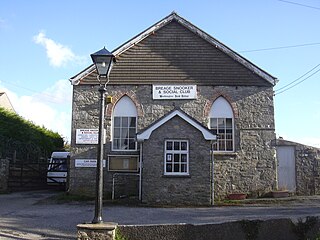Related Research Articles

Saint Piran or Pyran, died c. 480, was a 5th-century Cornish abbot and saint, of Irish origin. He is the patron saint of tin-miners, and is also generally regarded as the patron saint of Cornwall, although Saint Michael and Saint Petroc also have some claim to this title.

Saint Petroc or Petrock was a British prince and Christian saint.

Porthleven is a town, civil parish and fishing port near Helston in Cornwall, England, UK. As the most southerly port in Great Britain, it was originally developed as a harbour of refuge, when this part of the Cornish coastline was infamous for wrecks in the days of sail. The South West Coast Path from Somerset to Dorset passes through the town. An electoral ward called Porthleven and Helston South also exists. The population at the 2011 census was 3,059. It was estimated to be 3,141 in 2019.
Breage or Breaca is a saint venerated in Cornwall and South West England. According to her late hagiography, she was an Irish nun of the 5th or 6th century who founded a church in Cornwall. The village and civil parish of Breage in Cornwall are named after her, and the local Breage Parish Church is dedicated to her. She is a saint in the Eastern Orthodox Church and Catholic Church.

Saint Brioc was a 5th-century Welsh holy man who became the first abbot of Saint-Brieuc in Brittany. He is one of the seven founder saints of Brittany.

The culture of Cornwall forms part of the culture of the United Kingdom, but has distinct customs, traditions and peculiarities. Cornwall has many strong local traditions. After many years of decline, Cornish culture has undergone a strong revival, and many groups exist to promote Cornwall's culture and language today.

Breage is a civil parish and village in Cornwall, United Kingdom. The village is three miles (5 km) west of Helston.
Saint Kea was a late 5th-century British saint from the Hen Ogledd —the Brythonic-speaking parts of what is now southern Scotland and northern England. According to tradition he was chiefly active in Cornwall, Devon and Brittany, and his cult was popular in those regions as well as throughout Wales and the West Country. St Fili or Filius, to whom the parish church of Philleigh is dedicated, probably came from Wales and is said to have been a companion of St Kea.

Saint Sithney was a sub-Roman Celtic saint active in Cornwall and Brittany. He is the patron saint of mad dogs.

Sithney is a village and civil parish in West Cornwall, England, United Kingdom. Sithney is north of Porthleven. The population including Boscadjack and Crowntown at the 2011 census was 841.

Mabyn, also known as Mabena, Mabon, etc., was a medieval Cornish saint. According to local Cornish tradition she was one of the many children of Brychan, king of Brycheiniog in Wales in the 5th century. The village and civil parish of St Mabyn is named for her, and the local St Mabyn Parish Church is dedicated to her.
Saint Ia of Cornwall was an evangelist and martyr of the 5th or 6th centuries in Cornwall. She is said to have been an Irish princess, the sister of Erc of Slane and a student of Saint Baricus.
Branwalator or Breward, also referred to as Branwalader, was a British saint whose relics lay at Milton Abbas in Dorset and Branscombe in Devon. Believed to come from Brittany, he also gives his name to the parish of Saint Brélade, Jersey. "Brelade" is a corruption of "Branwalader". He is also known as Breward or Branuvelladurus or Brélade and Broladre in French.
Duloe is a village and civil parish in Cornwall, England, United Kingdom. It is situated approximately four miles (6 km) south of Liskeard at grid reference SX 233 585. The village of Herodsfoot and the hamlets of Churchbridge, Highercliff, Milcombe, Tredinnick, Trefanny Hill, Tregarlandbridge and Tregarrick Mill are also in the parish. The manors of Brodbane, Trenant, Lanwarnick, Killigorick and Tremadart are mentioned in the Domesday Book (1086).

Christianity in Cornwall began in the 4th or 5th century AD when Western Christianity was introduced into Cornwall along with the rest of Roman Britain. Over time it became the official religion, superseding previous Celtic and Roman practices. Early Christianity in Cornwall was spread largely by the saints, including Saint Piran, the patron of the county. Cornwall, like other parts of Britain, is sometimes associated with the distinct collection of practices known as Celtic Christianity but was always in communion with the wider Catholic Church. The Cornish saints are commemorated in legends, churches and placenames.
Elvan is the native variety of quartz-porphyry in Cornwall and Devon, England.

Penrose is a house and National Trust estate amounting to 1536 acres, east of Porthleven and in the civil parish of Sithney, Cornwall, England. The estate includes Loe Pool and Loe Bar which was given into the ownership of the National Trust in 1974 by Lt. Cdr. J. P. Rogers, and stretches along the coast to Gunwalloe. The estate was owned by the Penrose family for several hundred years before 1771 when it was bought for £11,000 by the Rogers family, whose descendants still reside in Penrose House.
Tewdwr Mawr was an early medieval king in Armorica and Cornwall.

Saint Germochus or Germoe was an early 6th century saint active in Cornwall and Brittany.
SaintRumon of Tavistock is a saint venerated in the traditions of the Catholic, Anglican Communion, and Western Orthodox churches.
References
- Orme, Nicholas (2000). The Saints of Cornwall. Oxford University Press. ISBN 0-19-820765-4 . Retrieved 19 January 2010.